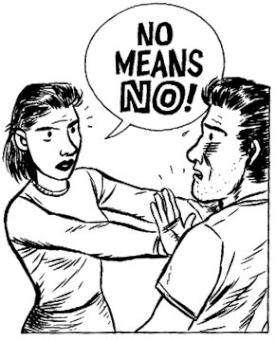Werewolf: Changing the Law on Rape
Can rape victims get a better deal?
Werewolf.co.nz September Issue Original Article
By Catriona MacLennan*
 New Zealanders like to think that we
live in a relatively egalitarian society, in which everyone
has at least some chance of a good life. Unfortunately, that
is not in fact the reality. For some New Zealanders, life is
nothing short of brutal. And it is those people – the
underprivileged who, statistically, are more likely than
middle class people to be the victims of crime – who also
have the most difficulty in obtaining justice from the legal
system.
New Zealanders like to think that we
live in a relatively egalitarian society, in which everyone
has at least some chance of a good life. Unfortunately, that
is not in fact the reality. For some New Zealanders, life is
nothing short of brutal. And it is those people – the
underprivileged who, statistically, are more likely than
middle class people to be the victims of crime – who also
have the most difficulty in obtaining justice from the legal
system.
A judge’s frustration at the lack of media reporting of some cases last year led him to take the unusual step of directing that his judgment be sent to his local paper and to other media outlets, in the hope that a spotlight would be cast on this violent underbelly.
Manukau District Court Judge Roy Wade was sentencing Atonio Simone on two counts of indecent assault, abduction, sexual violation by unlawful sexual connection, and rape. At the time of his offending, Simone was 36.
His victim was 12. She and her 13-year-old friend had concocted a scheme whereby they would pretend to be prostitutes in South Auckland. They intended to obtain money from a man by agreeing to have sex with him, but then running off once they had the cash.
The girls got into Simone’s vehicle, but were immediately frightened by his behaviour and decided to escape as soon as he stopped the car. The 13-year-old got away, but the younger girl did not. She repeatedly told the offender that she was only 12, but he would not let her go. Instead, he forced her to perform oral sex, then held her down and raped her, leaving bruises on her body.
The police were notified, but a DNA match was not found for a number of years. Simone pleaded guilty to two counts of indecent assault at the end of the Crown case, and was convicted by a jury on the other charges. By the time of his sentencing, his victim was 19.
 Judge Wade said that the brutal
experience she had undergone made her situation in life at
the end of her teens unsurprising. “I have to say that I
found it profoundly sad but entirely predictable that the
victim, then 12, and her 13-year-old friend Jasmine, now 19
and 20, both gave evidence having been produced from
custody: the victim at that stage serving a lengthy prison
sentence for aggravated robbery, and her friend for
manslaughter.
Judge Wade said that the brutal
experience she had undergone made her situation in life at
the end of her teens unsurprising. “I have to say that I
found it profoundly sad but entirely predictable that the
victim, then 12, and her 13-year-old friend Jasmine, now 19
and 20, both gave evidence having been produced from
custody: the victim at that stage serving a lengthy prison
sentence for aggravated robbery, and her friend for
manslaughter.
Of equal sadness is the fact that the horrifying facts of this case, which would (have been) expected to draw headline news throughout the country a few years ago, are today regarded as so mundane that the trial went entirely unreported and is therefore regarded as unremarkable. Such is life on the streets of South Auckland.”
The judge then went on to include a lengthy passage from the woman’s harrowing victim impact report in his sentencing notes.
“After the incident in August 2000 I never went back to school. My education ended when I was 12 years old. I was angry and full of shame. My family gave up on me, and I began living anywhere where I could find a bed for the night. My life spiralled out of control. Crime became the way I led my life, and I did not care who I hurt, just because I had nothing left to lose,” she said.
“The years since the incident are a blur of crime and drug use. In 2003 I gave birth to my son. I could not look after him. I had no home and no support. I made the hardest decision of my life and allowed the baby’s father’s parents to care for him. My self-worth was at an all-time low. I just continued to commit crime and prostitute myself to survive. The lowest of the low happened in 2006. I was charged with a series of aggravated robberies. I pleaded guilty and was sent to prison for a long time.”
The victim said that pleading guilty was the
first time she had taken responsibility for her actions, but
her downward spiral continued in jail.
She was angry and
self-harmed. When the police came to tell her that they had
found her rapist, it brought her pain back to the surface
and she did not at first want to testify. However, after
speaking to a counsellor and to the police, she decided to
give evidence.
The woman described the court process as frightening, and said that being cross-examined made her feel “small and useless.” She felt that she was on trial, and that it was her past which was being judged, instead of what the defendant had done to her. She went on to thank the jury, prosecutor, police and defendant’s ex-girfriend for believing in her.
Judge Wade said that the aggravating factors of the case were the vulnerability of the victim, who was 12 at the time and small and slight, and Simone’s premeditation. It was “chilling” that he had persisted with the rape despite knowing the victim’s age, and despite the fact that she cried throughout her ordeal.
Other aggravating features were the very serious impact of the offending on the victim, and the defendant’s lack of remorse. He said that the victim “was a prostitute anyway. She jumped inside the car voluntarily so I paid the money to her and she knows that’s her business.” Simone was sentenced to 10 years’ jail with a minimum non-parole period of six years.
Judge Wade concluded by saying that one of the most disturbing features of the case was the fact that it had gone totally unreported, as did nearly all of the cases at the Manukau District Court. He said that the court was wasting its time in imposing deterrent sentences if the public was left in total ignorance of what went on at the courthouse.
 The case of R v Simone is
typical of a majority of sexual offence trials in New
Zealand, in that the victims were children, but atypical in
the fact that the accused was convicted. Both reporting and
conviction rates in rape and other sexual offences’ cases
are extremely low in New Zealand.
The case of R v Simone is
typical of a majority of sexual offence trials in New
Zealand, in that the victims were children, but atypical in
the fact that the accused was convicted. Both reporting and
conviction rates in rape and other sexual offences’ cases
are extremely low in New Zealand.
In the ten years to 2005, an average of 31 per cent of rape charges resulted in convictions, The figure for the previous decade was 38 per cent. The conviction rate for other types of violent offences is 55 per cent, which is itself a lower rate than the overall conviction rate of 70 per cent for all types of offences.
Further, the rape conviction figure is dramatically lower in cases in which the accused is known to the complainant. Rape Crisis estimates that only one in ten rapes will be reported, and only five per cent will be prosecuted.
One study found that 83 per cent of victims felt that they, rather than the defendant, were on trial.
In the United Kingdom, research established that, after allowing for withdrawn cases, 21 per cent of reported rape offences went to court, and only 12 per cent of those resulted in convictions. By contrast, in South Africa, where specialist sexual offences’ courts have been established, the conviction rate for sexual offences is more than 80 per cent.
An Australian Institute of Criminology study concluded that jurors tended to have preconceived ideas about rape, with their expectations about how “real” victims behaved before, during and after sexual assaults impacting on their assessments of complainants’ credibility. The same study highlighted that jurors had difficulty in understanding what was meant by the legal definition of consent.
That finding is backed up by research carried out in New Zealand by clinical and forensic psychologist Suzanne Blackwell, which is of considerable concern. She found that verbatim comments from jurors suggested that they were likely to acquit in the absence of direct evidence, even when they knew that the objective probability of the accused’s guilt was sufficient to convict.
Dr Blackwell said in relation to child sexual
assault trials that jurors did not appear to consider that
the evidence of the complainant was “evidence.”
Those
interviewed repeatedly said that they had believed the
complainant but there was “just not enough evidence.”
This is consistent with the “CSI effect” which has
raised jurors’ expectations of forensic evidence in every
trial.
Dr Blackwell’s research also showed that some jurors interpreted “beyond reasonable” doubt as meaning “absolute proof,” a standard which they did not believe could actually be reached. Dr Blackwell has collected verbatim data from jurors who commented on the perceived lackluster performances of prosecutors in comparison to the perceived aggression displayed by some defence counsel. Some jurors attributed this to the prosecutors themselves not believing the complainants.
Other misconceptions voiced by
jurors were that child sexual abuse was rare, that there
would always be physical damage which would be detected by a
medical examination and that children were coached in their
evidence.
Particularly alarmingly for the credibility of
the legal system, Dr Blackwell concluded that verdicts in
child sexual assault cases could be predicted prior to a
trial by the existence or otherwise of evidential variables
relating to corroboration, seriousness and topography of the
offending, the number of charges, and the age of the
victim.
Bluntly put, most juries in New Zealand will not convict on the evidence of most child sexual offence complainants.
 Reform of
sexual offences’ trial processes has been under
consideration for a number of years in New Zealand, and
changes to the law are now expected in the near future. The
Public Issues Committee of the Auckland District Law Society
in June 2002 issued a paper calling for a review of the
procedures by which rape and other sexual offences were
tried. It also advocated the establishment of a taskforce,
saying that there was a substantial degree of
underreporting, the ultimate outcome of which was an
undermining of confidence in the legal system.
Reform of
sexual offences’ trial processes has been under
consideration for a number of years in New Zealand, and
changes to the law are now expected in the near future. The
Public Issues Committee of the Auckland District Law Society
in June 2002 issued a paper calling for a review of the
procedures by which rape and other sexual offences were
tried. It also advocated the establishment of a taskforce,
saying that there was a substantial degree of
underreporting, the ultimate outcome of which was an
undermining of confidence in the legal system.
The paper suggested that sexual offences’ victims could be represented by their own lawyers, an inquisitorial process rather than an adversarial system could be used, and the right to silence could be removed.
A forum held in Auckland in November 2003 attended by judges, lawyers and the police discussed a range of options for reform. I was surprised at the level of agreement among the different groups present that major changes were required to the current processes.
Suggestions canvassed included the introduction to New Zealand of the Canadian law placing the onus of establishing consent on defendants, specialist sexual offences’ courts modelled on those in South Africa, state-funded legal representation for complainants as in Ireland, Denmark and Germany, and greater judicial intervention of limit degrading and oppressive questioning of complainants.
Barrister Paul Dacre at that forum queried why, in cases in which a single matter was at issue, victims should be put through the ordeal of the trial process. For example, it might be accepted that the complainant had been raped. If identification was the matter at issue, and the victim could not identify the defendant, DNA evidence would be critical.
If that were the case, Mr Dacre suggested that admissions should be made and facts should be agreed before the hearing, The trial could then be narrowed to the real issue in dispute. Mr Dacre commented that it was a strange society in which there was a specialist commercial list court, but no emphasis was placed on the speedy disposal of criminal cases involving vulnerable people.
 Retired Court of Appeal Judge Ted
Thomas has in recent years been outspoken in his criticisms
of current sexual offences’ trial processes.
Retired Court of Appeal Judge Ted
Thomas has in recent years been outspoken in his criticisms
of current sexual offences’ trial processes.
In a speech in 2008 about the Evidence Act 2006, he said that victims of rape or sexual abuse had always been at a disadvantage in the courtroom and recent law changes had turned the clock back on improvements.
He said that the act codified a conservative view of the law of evidence, with this being nowhere more evident than in the legislature’s treatment of sexual offence cases. The relatively low convictions rates in sexual offences’ cases were evidence of the disadvantages faced by complainants.
“Myths persist, such as the belief that women are prone to fabricate allegations of rape and that it is the “natural reaction” of “normal” women to complain promptly. These man-made fables are insufficiently refuted in the courtroom. The judiciary has generally failed to assimilate the learning of other disciplines in this area of the law.”
Justice Thomas said that the plight of sexual assault victims had been mitigated by a number of legislative provisions aimed at alleviating the ordeal of the courtroom experience, and the prohibition on cross-examination relating to the complainant’s prior sexual experience without leave. However, he said that the understanding which motivated those reforms was lacking in the new act.
Justice Thomas identified two areas of concern. The first was the restriction on comment on the accused’s silence at trial. The second was the prohibition against evidence of previous statements by complainants in sexual cases other than in limited circumstances.
“My core criticism is that the act fails to make discrete provision for sexual cases and, in the result, is unfair to complainants.” Elaborating on his first concern, Justice Thomas said that sections 32 and 33 of the Evidence Act provided that the fact-finder was not to be invited to infer guilt from the accused’s silence either before or at trial.
“It is anachronistic to prevent the prosecution commenting on the fact the accused did not give evidence in the context of what is still an adversarial process. Either the accused’s silence should be open to comment or it should not.” He described it as “nothing short of a gross injustice” to complainants when the accused did not give evidence and no adverse inference could be drawn from that silence.
Justice Thomas said that there was a growing consensus that, without overriding basic adversarial structures, proceedings for sexual offences should be more concerned to arrive at the truth. He said that it was essentially unfair for the accused to be able to cross-examine the victim and seek to cast doubt on her credibility and integrity, but for the accused to be able to remain silent without any inference being drawn. Justice Thomas suggested that, in sexual cases, it should be open to the jury to draw adverse inferences from an accused failing to give evidence.
In relation to his second concern about the restriction on the admission of previous statements, Justice Thomas said that section 35(2) made the defence the gatekeeper of the admissibility of the complainant’s prior complaint. The subsection was, he said, drawn in unnecessarily narrow terms.
An alternative provision was accordingly required to ensure justice in sexual cases. The reality of trials for rape or sexual abuse was that the defence was almost always challenging the veracity of the complainant. “It makes little or no sense to restrict her ability to lead evidence of her disclosure to those cases where the defence chooses to formulate its challenge in a particular manner.”
 Justice Thomas went on to say that
the authors of the act appeared to have ignored or rejected
recent case law such as R v Baker, in which the Court
of Appeal had placed primary reliance on relevance and
reliability as the criteria for the admission of evidence.
Justice Thomas concluded that it was unfortunate that, at a
time when the plight of victims in sexual cases had received
wide publicity, Parliament should have enacted a statute
which disadvantaged complainants in significant
respects.
Justice Thomas went on to say that
the authors of the act appeared to have ignored or rejected
recent case law such as R v Baker, in which the Court
of Appeal had placed primary reliance on relevance and
reliability as the criteria for the admission of evidence.
Justice Thomas concluded that it was unfortunate that, at a
time when the plight of victims in sexual cases had received
wide publicity, Parliament should have enacted a statute
which disadvantaged complainants in significant
respects.
“Their vital interests have been subjected to the optimistic belief that a general rule will fit all. Sexual cases could be sensibly and sensitively dealt with in separate provisions that have full regard to the unique features which set these cases apart.” He suggested that archaic language, such as the word “complaint,” could be abandoned, and other provisions in the act relating to sexual cases could be assembled in the same part.
Consideration could be given to adding new provisions appropriate in sexual cases. “For example, the defence could be required to disclose the grounds of the defence and the names of any proposed witnesses in order to avoid the complainant being “ambushed.” The circumstances in which an accused’s previous convictions for sexual offences could be produced in evidence by the prosecution could also be covered. A straightforward section could clarify that the other provisions of the act apply to sexual cases except where inconsistent with the provisions of that part.”
Justice Thomas said that section 202
required the act to be reviewed at least once every five
years. He said that, for the most part, reforms which might
have been pressed in the courts would now need to be pursued
politically.
“It is my hope that the legal profession,
prompted, perhaps, by women’s organisations, will take up
the challenge and press for a review of the act and the
enactment of discrete provisions which will reflect a more
enlightened outlook and a desire to ensure justice for the
victims, as well as the accused, in sexual cases.”
The Law Commission in May 2008 released a report titled Disclosure to Court of Defendants’ Previous Convictions, Similar Offending, and Bad Character. The paper was prompted by the public disquiet expressed at the non-disclosure to the jury of the previous convictions of two former police officers who were tried and acquitted of sexual offending.
 In a foreword to the
paper, Law Commission president, Sir Geoffrey Palmer, said
that the commission had arrived at the view that “all was
not well” with the traditional trial process in New
Zealand in relation to sexual offending:
In a foreword to the
paper, Law Commission president, Sir Geoffrey Palmer, said
that the commission had arrived at the view that “all was
not well” with the traditional trial process in New
Zealand in relation to sexual offending:
“The issues that have come to our notice during the course of this project cannot simply be cured by changes to the law of evidence. Problems in the system flow from the features of the adversarial system of trial that is, as presently constituted, an essential feature of our system of justice in New Zealand.
“The commission’s consultation in the course of this reference sowed the seeds of doubt in our mind regarding the efficacy and fairness of the Westminster-style adversarial trial ad it applies to unlawful sex cases in New Zealand. We listened carefully to the experiences of Louise Nicholas and others and we found persuasive some of their arguments about the defects in the current process. We are not in a position to make findings about this because it is outside our terms of reference for this inquiry. But we harbour lingering worries.”
Sir Geoffrey went on to suggest that there could be value in investigating whether or not the adversarial system should be modified or replaced with an alternative model, either for sexual offences or for some wider class of offences. The law relating to sexual offences’ trial processes has also been examined in detail by the Ministry of Justice, which produced an August 2008 public discussion document titled Improvements to Sexual Violence Legislation in New Zealand.
The document sought submissions on a range of
options for reform.
These included –
*introducing a positive definition of consent to sexual activity to sit alongside the list of circumstances in which consent is deemed not to be present
* requiring courts determining whether or not an accused had reasonable grounds to believe that a complainant consented to sexual activity to have regard to any steps taken by the accused to ascertain whether or not the complainant is consenting
*amending the Evidence Act 2006 to extend the “rape shield” so that evidence about previous sexual experience between the complainant and any person, including the accused, is inadmissible, without the prior agreement of the judge
*an inquisitorial approach to criminal trial procedure, the use of restorative justice in some sexual offence cases, specialist sexual offences courts, and one-stop-shop sexual assault referral centres.
Other reform initiatives include the Taskforce for Action on Sexual Violence, which was due to provide a final report by 31 July 2009, and research work being undertaken by Professor Jeremy Finn, Associate Professor Elisabeth McDonald and Dr Yvette Tinsley.
The three academics are investigating whether an inquisitorial system should be introduced for sexual offence trials, whether there should be a change to the onus of proof when consent is an issue and whether specialist courts or tribunals should be established to hear sexual offence cases.
 Justice Minister Simon
Power in June asked the Law Commission to investigate
whether an inquisitorial system should be used in sexual
offending and child abuse cases.
Justice Minister Simon
Power in June asked the Law Commission to investigate
whether an inquisitorial system should be used in sexual
offending and child abuse cases.
The minister said that he was considering potentially far-reaching reforms, including –
*the introduction of a positive definition of consent
*a requirement that the court consider any steps taken by defendants to ascertain whether or not victims consented, and
*making evidence about previous sexual relationships between complainants and any persons inadmissible without the prior agreement of the judge.
Power called for an open debate about the way
sexual violence cases were conducted, saying that such
discussion was required if New Zealand wished to improve on
the reporting rate of between nine and 12 per cent for
sexual violation offences.
Power plans to travel overseas in 2010 to assess the use of the inquisitorial system in sexual offence cases. The thorniest issue in sexual offence cases involving adult complainants is that of consent. Improvements in forensic technology mean that far better physical evidence is now available to prosecutors.
It would be an interesting statistical project to analyse whether there is a correlation between the number of sexual assault cases in which consent is used as a defence, and improvements in DNA evidence. My view would be that statistics would be likely to show a trend towards increasing use of a consent defence as more sophisticated forensic evidence has made other defences more difficult to mount.
 The nadir in relation
to the law relating to consent was the 1976 English case of
R v Morgan, known to women’s groups as “the
rapist’s charter.” In that case, a husband brought
friends home to rape his wife. He told them that she would
say “no” and struggle and scream, but that they should
ignore her cries for help as her struggles really mean that
she was enjoying the ordeal.
The nadir in relation
to the law relating to consent was the 1976 English case of
R v Morgan, known to women’s groups as “the
rapist’s charter.” In that case, a husband brought
friends home to rape his wife. He told them that she would
say “no” and struggle and scream, but that they should
ignore her cries for help as her struggles really mean that
she was enjoying the ordeal.
The men were acquitted as the court held that, if they honestly believed that the woman was consenting, they could not be convicted. It did not matter how unreasonable the belief was, as long as it was honestly held. The case became part of legal precedent and was used to acquit a string of other men in later trials.
Consent will invariably cause difficulties for the
prosecution as it is required to prove its case beyond
reasonable doubt. If there is considered to be any doubt, it
is the defendant who is entitled to the benefit, not the
complainant.
A number of countries have in recent years
sought to deal with the issue of consent in sexual assault
cases.
Canada, the United Kingdom and Australia have reformed their laws with the aim of displacing preconceptions about sexual violence and consenting behaviour, and providing legislative statements of appropriate standards of sexual interaction. Those countries have introduced statutory definitions of consent and set out lists of circumstances in which consent does not exist.
Scotland is at present amending its law to include a positive definition of consent.
The Canadian Criminal Code states that consent means “the voluntary agreement of the complainant to engage in the sexual activity in question.”
The United Kingdom’s Sexual Offences Act states that “ a person consents if he agrees by choice, and has the freedom and capacity to make that choice.”
The New South Wales Crimes Amendment (Consent-Sexual Assault Offences) Act provides that there is consent “if the person freely and voluntarily agrees to the sexual intercourse.” However, in the United Kingdom the 2005 case of R v Dougal raised concerns about the operation of the new law, after the judge in a rape trial directed the jury to enter a ‘Not Guilty’ verdict when the prosecution advised that it was unable to prove that the complainant had not given consent because of her level of intoxication.
A 2006 report, Convicting rapists and protecting victims – justice for victims of rape, prepared by the Office for Criminal Justice Reform, accordingly proposed further changes. New Zealand should follow other jurisdictions and reform its law relating to consent.
However, what is also required is a huge change in attitude by men towards both women and sex. It is well past time to continue accepting that repeated pack rapes by some sports teams are normal and acceptable behaviour. Similarly, giving men the benefit of the doubt when they have sex with women who are asleep, too drunk to speak, or saying “no” but allegedly not meaning “no” has had its day.
It’s really very simple: don’t have sex unless she agrees to it.
If you’re not sure whether or not she is consenting, don’t have sex.
*Catriona MacLennan is a South Auckland barrister and journalist.
ENDS


 Gordon Campbell: On The Coalition’s Awful, Not Good, Very Bad Poll Results
Gordon Campbell: On The Coalition’s Awful, Not Good, Very Bad Poll Results Ian Powell: Policy Vacuum Enables For-profit Corporate General Practice Ownership By Stealth
Ian Powell: Policy Vacuum Enables For-profit Corporate General Practice Ownership By Stealth Gordon Campbell: On Iran Killing Its Rappers, And Searching For The Invisible Dr. Reti
Gordon Campbell: On Iran Killing Its Rappers, And Searching For The Invisible Dr. Reti Peter Dunne: MPs Unusually Quiet On Pay Rise
Peter Dunne: MPs Unusually Quiet On Pay Rise Ian Powell: Cuba And New Zealand: A Relationship Worthy Of Strengthening
Ian Powell: Cuba And New Zealand: A Relationship Worthy Of Strengthening Gordon Campbell: On bird flu, AUKUS entry fees and Cindy Lee
Gordon Campbell: On bird flu, AUKUS entry fees and Cindy Lee